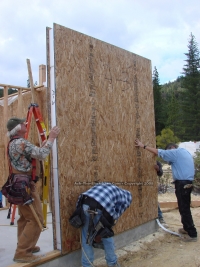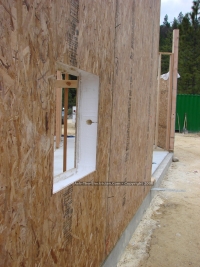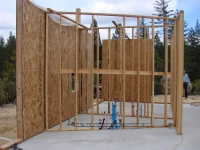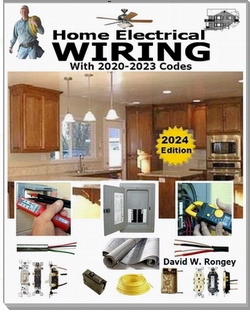» Home
» Electrical Wiring Directory
» Wiring Energy Efficient SIP Homes
» Need Electrical Help? Ask the Electrician
» Need Electrical Help? Ask the Electrician
Green Energy Efficient Homes
Building and Wiring a SIP Home - Part 3
 |
By Dave Rongey
Summary: SIP Homes typically take far less time to build than a traditional stick-frame home. |
Styrofoam Insulated Panel Homes require less construction time
SIP Home Construction - Series 4
This series of pictures shows the walls being set into place.
Special attention to fitting the panels together side-by-side sometimes requires adjustments.
SIP Home - Styrofoam Insulated Panel Home Construction |
|
Once the building contractor has put all the walls and ceiling panels in place its time to install the electrical circuits and wiring. It is best for the sub-contractors to be on site for part of the building process so they can begin to plan for their installation process. |
 |
Each SIP Home is engineered and the SIP Panels are delivered pre-cut to size ready for installation. The concrete foundation was equipped with hold down bolts used to fasten a 2 x 6 plate on top of the slab which served as the bottom anchor then 6 x 6 posts (shown above) were installed between the panels which will be used for a splice and structural support for the upper floor. |
|||||
 |
|
|
The Safest Way to Test Electrical Devices and Identify Electric Wires!The Non-Contact Electrical TesterThis is a testing tool that I have had in my personal electrical tool pouch for years, and is the first test tool I grab to help identify electrical wiring. It is a Non-contact tester that I use to easily Detect Voltage in Cables, Cords, Circuit Breakers, Lighting Fixtures, Switches, Outlets and Wires. Simply insert the end of the tester into an outlet, lamp socket, or hold the end of the tester against the wire you wish to test. Very handy and easy to use.
The Quickest Way to Check for Faulty Electrical Wiring!The Plug-In Outlet TesterThis is the first tool I grab to troubleshoot a problem with outlet circuit wiring. This popular tester is also used by most inspectors to test for power and check the polarity of circuit wiring. It detects probable improper wiring conditions in standard 110-125 VAC outlets Provides 6 probable wiring conditions that are quick and easy to read for ultimate efficiency Lights indicate if wiring is correct and indicator light chart is included Tests standard 3-wire outlets UL Listed Light indicates if wiring is incorrect Very handy and easy to use.
Strip Off Wire Insulation without Nicking and Damaging the Electric Wire!The Wire Stripper and Wire CutterMy absolute favorite wire stripping tool that I have had in my personal electrical tool pouch for years, and this is the tool I use to safely strip electrical wires. This handy tool has multiple uses: The wire gauges are shown on the side of the tool so you know which slot to use for stripping insulation. The end of the tool can be used to grip and bend wire which is handy for attaching wire onto the screw terminals of switches and outlets.. The wire stripper will work on both solid and stranded wire. This tool is Very Handy and Easy to Use. |
||
Residential Electrical Parts and AccessoriesLight Switches 120volt Outlets Circuit Breakers Electrician Tools Voltage Testers |
















